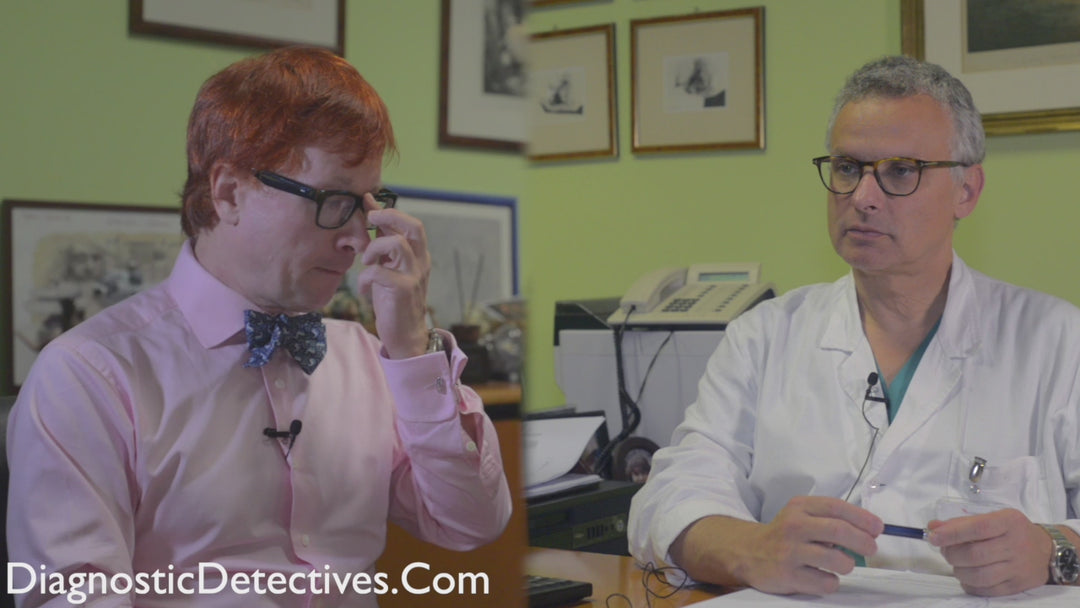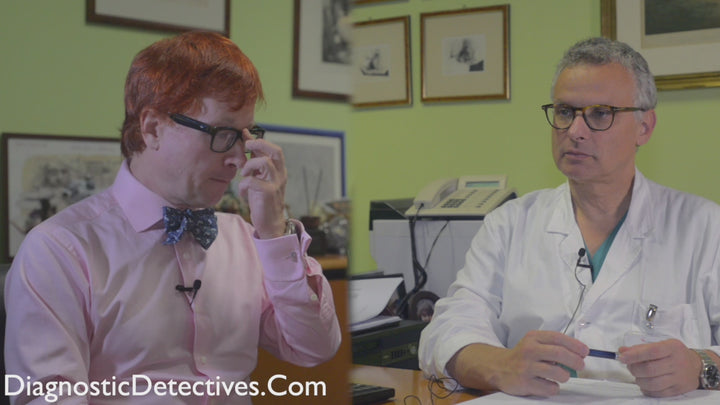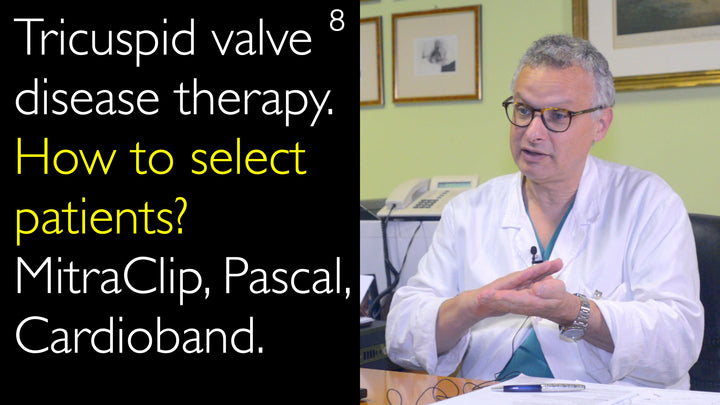Leading expert in tricuspid valve disease therapy, Dr. Francesco Maisano, MD, explains modern treatment options. He details patient selection for procedures like MitraClip, Pascal, and Cardioband. Dr. Francesco Maisano, MD, discusses the complexities of surgical and transcatheter repair versus replacement. He highlights the critical role of diagnostic imaging in determining the best approach. Dr. Francesco Maisano, MD, also describes a new international working group focused on improving tricuspid valve care.
Advanced Treatment Options for Tricuspid Valve Regurgitation
Jump To Section
- Tricuspid Valve Disease Overview
- Surgical Treatment Options
- Transcatheter Repair Techniques
- Tricuspid Valve Replacement
- Patient Selection Criteria
- Future of Tricuspid Therapy
- Full Transcript
Tricuspid Valve Disease Overview
Tricuspid valve regurgitation is a serious heart valve condition. Dr. Francesco Maisano, MD, notes it often occurs after heart attacks or in patients with heart failure. Pulmonary artery hypertension is another common cause of tricuspid valve insufficiency. Elderly patients are also frequently affected by this valvular heart disease.
The condition involves a leaky valve that allows blood to flow backward. This can lead to right heart failure and significant symptoms like fatigue and swelling. Dr. Anton Titov, MD, discusses the diagnostic challenges with Dr. Francesco Maisano, MD. Accurate imaging is crucial for assessing the severity and mechanism of the leak.
Surgical Treatment Options
Open-heart surgery remains a gold standard for tricuspid valve disease treatment. Dr. Francesco Maisano, MD, explains that high-volume centers often use a minimally invasive approach. This surgery is typically performed on a beating heart through a small incision. Surgeons can either repair or replace the damaged tricuspid valve.
Annuloplasty is the most common surgical repair technique. Dr. Francesco Maisano, MD, states that almost 90% of surgical patients receive this procedure. It involves placing a ring to reshape and tighten the dilated valve annulus. For complex cases, additional techniques like the clover repair or leaflet augmentation may be used.
Transcatheter Repair Techniques
Transcatheter therapies offer less invasive options for high-risk patients. Dr. Francesco Maisano, MD, highlights two CE-marked devices: MitraClip and Pascal. These systems perform a transcatheter edge-to-edge repair (TEER) of the tricuspid valve. The Cardioband device provides a transcatheter annuloplasty solution.
Dr. Maisano cautions that most other transcatheter devices remain in research stages. Over 30 different devices are in development for tricuspid regurgitation. None have yet achieved the clinical evidence needed for widespread adoption. Dr. Francesco Maisano, MD, emphasizes these procedures are highly dependent on advanced imaging guidance.
Tricuspid Valve Replacement
Tricuspid valve replacement becomes necessary when repair is not feasible. Dr. Francesco Maisano, MD, discusses the challenging choice between bioprosthetic and mechanical valves. Mechanical valves carry a higher thrombosis risk on the right side of the heart. Valve replacement also complicates future pacemaker implantation if needed.
Replacement is indicated when significant leaflet tethering is present. Dr. Francesco Maisano, MD, explains that annuloplasty alone often fails in these cases. The decision must consider potential afterload mismatch following replacement. Both surgical and emerging transcatheter replacement options are available for select patients.
Patient Selection Criteria
Proper patient selection is critical for successful tricuspid valve therapy. Dr. Francesco Maisano, MD, provides a straightforward framework for decision-making. Treatment depends on whether the leak is caused by annular dilation or leaflet tethering. Annuloplasty works best for isolated annular dilation without tethering.
Patients with significant leaflet tethering require different approaches. Dr. Maisano recommends either edge-to-edge repair or valve replacement for these cases. The etiology of regurgitation also guides treatment selection. Secondary regurgitation from pulmonary hypertension often responds poorly to annuloplasty alone.
Future of Tricuspid Therapy
Tricuspid valve treatment is evolving rapidly through international collaboration. Dr. Francesco Maisano, MD, leads the PCR Tricuspid Focus Group with Dr. Fabien Praz. This working group includes approximately 70 experts from Europe and the United States. They meet regularly to establish best practices for patient selection and procedure choice.
Dr. Maisano believes the field will continue developing over the next few years. Standardized approaches will make these therapies safer and more widely available. Dr. Francesco Maisano, MD, emphasizes that tricuspid valve disease requires highly individualized treatment plans. Dr. Anton Titov, MD, concludes the discussion by highlighting the importance of this ongoing research.
Full Transcript
Dr. Anton Titov, MD: Tricuspid valve regurgitation diagnosis and treatment methods have improved recently. Tricuspid valve insufficiency happens after heart attacks, in heart failure, and in pulmonary artery hypertension. Tricuspid valve regurgitation also happens often in elderly patients. You are a leading surgeon in mitral valve and tricuspid valve repair with open heart surgery and endovascular techniques. What are the different treatment options today for tricuspid valve disease treatment?
Dr. Francesco Maisano, MD: Tricuspid valve disease treatment has a large number of potential options. Obviously, starting with open-heart surgery, we can treat almost every patient minimally invasively. Surgery can be done both if the patient has been previously operated on or not. I think almost every high-volume center will offer a less invasive approach.
It is usually done on a beating heart with a small incision. You can replace or repair the tricuspid valve. In tricuspid valve replacement, it is always difficult to choose between bioprosthesis and mechanical prosthesis because the risk of thrombosis on the right side is always a bit higher. There is also another problem with the implantation of tricuspid valves.
You are limited in case you also need to implant a pacemaker. So the gold standard remains tricuspid valve annuloplasty and tricuspid valve repair. But we know that there are some patients who are not responding to tricuspid valve annuloplasty because of the geometrical changes of the right ventricle. So in these patients, we need to go for tricuspid valve replacement.
In terms of repair, almost 90% of patients are treated just by annuloplasty. A small percentage of patients receive more treatment than annuloplasty. This can be an edge-to-edge tricuspid valve repair. It is called the clover technique. Another method is leaflet augmentation.
These are the two most commonly used techniques of tricuspid valve repair, in addition to annuloplasty. But I would say that on many occasions, if the surgeon predicts no effect from tricuspid valve annuloplasty, then it is a low threshold to go for tricuspid valve replacement.
Now when we go into transcatheter treatment methods of tricuspid valve prolapse, then we have a huge number of options. Most of these options are still in the early stage of the research status. There are very few CE-marked procedures.
Namely, we have transcatheter edge-to-edge with MitraClip and Pascal. And we have annuloplasty with Cardioband. That's it. This is what we have. There is also another line, but it's not anymore available in practice. The rest of the tricuspid transcatheter repair methods are available only as part of a research project.
We have done several tricuspid valve replacements. We can make different annuloplasty approaches. We have also done out-of-the-box procedures for the tricuspid valve prolapse. There are, I think, more than 30 different devices available for tricuspid valve prolapse treatment.
And none of them really reached the numbers needed to get a CE mark approval. On the other side, none has become a real alternative to edge-to-edge tricuspid valve repair and annuloplasty, which are now available for tricuspid valve prolapse. So that means a lot.
It means that tricuspid valve prolapse remains a challenging procedure. It is highly dependent on diagnostic imaging, and all these solutions are difficult to be adapted to the different subcategories of tricuspid valve prolapse disease.
So again, if you have an atherogenic tricuspid regurgitation with less tethering, you may think about implanting annuloplasty. Tricuspid regurgitation in the setting of atherogenic tricuspid regurgitation can be treated with annuloplasty. But effectively, if it is a secondary tricuspid regurgitation to pulmonary hypertension, annuloplasty may not work because leaflets are fatter.
So in these cases, you need to think about the edge-to-edge tricuspid valve repair or a combination of edge-to-edge repair plus annuloplasty. Or we need to think directly about tricuspid valve replacement. But then, in tricuspid valve replacement, you need to get to the question of afterload mismatch.
So it's very complicated decision-making in tricuspid valve prolapse treatment. We established already almost one year ago the working group on tricuspid valve treatment. I lead this working group together with Dr. Fabien Praz from Bern.
The working group is called the PCR Tricuspid focus group. It includes about 70 experts, mostly from Europe. We also have some United States-based colleagues. We meet pretty often to discuss all these aspects and to try to understand what is the best solution for each category of tricuspid valve disease.
What to do, how to select the best patients for annuloplasty, for edge-to-edge tricuspid valve repair, and for replacement of the tricuspid valve. And still, we are learning. It will take another few years before this technology will be widely available, safe enough, and performed in every hospital in the world.
Dr. Anton Titov, MD: So patient selection clearly is very important for tricuspid valve repair or replacement either by open surgery or by transcatheter methods. What are the broad categories of patients for tricuspid valve treatment? What helps you to select the appropriate procedure for the appropriate patient?
Dr. Francesco Maisano, MD: We think it is very easy. Let's make it. So it's a complicated question, but we make it very easy. There are two conditions that create a leaky valve. Either it's the annulus that is dilated, so the leaflets are pulled away. Or it is a ventricle that is dilated, and the leaflets of the valve are pulled down.
The combination of the two features drives the decision on treatment selection. In the case of annular dilatation, annuloplasty is the best solution. In the case of tricuspid valve leaflet tethering, annuloplasty will not work. So you need to think about either transcatheter edge-to-edge repair or tricuspid valve replacement.
And this applies to surgical operations as well. If you have valvular leaflet tethering, you will replace the tricuspid valve. If the tricuspid valve is not tethered, you can put the annuloplasty ring, and usually it works.







